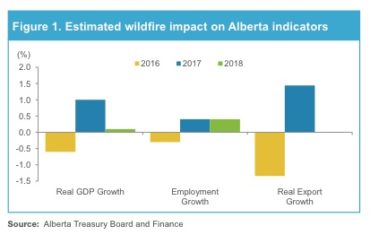
Impact of Fort Mac wildfire adds to Alberta’s economic challenges, increases deficit: province
August 24, 2016 by Angela Stelmakowich
Print this page Share
Costs associated with the wildfire that ravaged parts of Alberta’s Wood Buffalo region this past May, coupled with the impact of ongoing low oil prices, has set the provincial government on a continuing cautious course to its finances.
 “In the face of the oil price collapse and the economic impact of the wildfires, our government continues to take a prudent approach, controlling spending, protecting critical public services, and taking action to create jobs and diversify our economy,” Joe Ceci, Alberta’s finance minister and president of Treasury Board, says in an Alberta Treasury Board and Finance press release Tuesday.
“In the face of the oil price collapse and the economic impact of the wildfires, our government continues to take a prudent approach, controlling spending, protecting critical public services, and taking action to create jobs and diversify our economy,” Joe Ceci, Alberta’s finance minister and president of Treasury Board, says in an Alberta Treasury Board and Finance press release Tuesday.
“The steep and prolonged drop in oil prices continues to have a profound impact on Alberta’s economy,” notes Alberta’s 2016-17 First Quarter Fiscal Update and Economic Statement.
“This year, the impact has spread beyond the energy sector. Housing, retail activity, construction, labour markets and manufacturing are all showing significant signs of weakness,” the fiscal update adds.
The net fiscal impact of the Wood Buffalo wildfire is forecast at an estimated $500 million for 2016-2017, the press release states.
That total is calculated based on $647 million in disaster relief assistance minus $452 million in federal transfers, plus $300 million in lost revenue (revenue from corporate and personal income taxes and non-renewable resources).
Related: Direct economic impact of Fort McMurray wildfire expected to reach US$5 billion: Impact Forecasting
Looking specifically at disaster/emergency assistance expense, provincial figures show this had been budgeted for $246 million in 2016-2017, but the 2016 Q1 forecast is $1,072 million.
This includes $647 million reported in 2016-2017 expense for the Wood Buffalo DRP (disaster recovery program), $369 million for wildfire-fighting costs and $9 million in 2013 Alberta flood assistance from 2015-2016, partly offset by the $200 million in unallocated disaster assistance included in the budget.
“Total expenses are forecast to increase due largely to the Wood Buffalo Disaster Recovery Program, additional disaster assistance and capital grants,” the ministry notes.
“With this and other changes, the deficit is forecast to be $10.9 billion, $527 million higher than estimated at budget,” the province adds
“Essentially, were it not for the Wood Buffalo wildfire, the deficit projection for this year would be on track,” Ceci said during a press conference.
More positively, the ministry reports that the revenue forecast has increased by $708 million, largely as a result of an adjusted forecast for the West Texas Intermediate (WTI) oil price from $42/barrel to $45/barrel and higher-than-expected federal transfers, including $452 million in disaster assistance.
“Oil production disruptions associated with the Fort McMurray fires and instability in Libya and Nigeria have reduced supply and provided some support to oil prices so far this year,” the fiscal update notes.
“While the adjusted forecast for the WTI oil price has increased modestly, the government is maintaining the full $700-million risk adjustment to account for potential oil price volatility,” the press release states.
Related: PCS re-survey estimates $4.67 billion in insured damage from Fort McMurray wildfire
“Our commitment to support rebuilding after this year’s wildfires will help spur economic recovery in 2017, protecting thousands of jobs for Alberta families,” Ceci says.
“While clean-up and reconstruction efforts will provide a positive contribution to GDP growth in the coming years, the disruption to capital projects and oil production will outweigh those effects in 2016,” notes the fiscal update.
“The estimated net impact on real GDP growth in 2016 is a reduction of 0.6 percentage points.”
The ministry reports, however, that the provincial economy is expected to begin recovering in 2017, following a two-year recession.
“Real GDP is forecast to grow by 2.4% in 2017, supported by wildfire reconstruction, a rebound in oil production, additional investments in public-sector infrastructure, and a modest improvement in oil prices,” the ministry adds.
“In addition to displacing roughly 2% of Alberta’s population, the fire destroyed 2,302 individual residential units, contained in 1,599 structures. The remaining destroyed units were primarily in Anzak, Draper and Saprae Creek, communities southeast of the city,” the fiscal update reports.
There were 15 commercial properties destroyed, as well as hundreds of residential and commercial properties damaged, the update reads.
“Even considering the significant slack in the labour market that the construction industry can tap into, residential reconstruction efforts will likely extend beyond 2018,” the fiscal update notes. “Over the entire reconstruction phase, over $1 billion is expected to be spend on residential rebuilding.”
Beyond reconstruction of destroyed and damaged structures, it continues, “investment in infrastructure to mitigate future risks is expected, but will also take years to complete.”
The fiscal update notes 2016-2017 Capital Plan spending is forecast to be $8.7 billion, an increase of $245 million from Budget 2016.
“This comprises primarily $101 million in 2015-2016 projects carried over to the current year, mostly related to 2013 Alberta flood assistance, $100 million in federal infrastructure program funding for public transit, water/wastewater and social housing projects, $68 million in additional SUCH sector (school boards, universities, colleges and health entities) projects, and a net $24 million reduction due mainly to re-profiling of projects in future years,” it states.
“The bottom line is this in this Q1 update: The oil price collapse continues to reverberate through our economy,” Ceci told reporters. “The Wood Buffalo wildfire has added considerably to the economic impact, reducing revenue and royalties to government.”


Have your say: